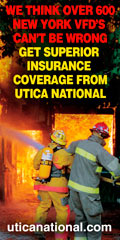
| Archives/Subscribe | Advertise | NYS Fire Chiefs | Size Up | September 2011 |
Focus on Fire Safety: Emergency Preparedness
Tips from U.S. Fire Administration - FEMA Disaster preparedness became a renewed priority for our nation as a direct response to the devastation of the terrorist attacks of September 11, 2001. Following the tragedies of that day, government at all levels has worked more closely with civic and private sector organizations and the public to prepare for emergencies. Americans need to become fully aware, trained, and practiced on how to respond to potential threats and hazards. Preparedness starts with YOU! Everyone should:
Each person's needs and abilities are unique but every individual can take important steps to prepare for all kinds of emergencies – including fire emergencies – and put plans in place. Prepare for a Fire Emergency
In less than 30 seconds, a small flame can get completely out of control and turn into a major fire. It only takes minutes for a house to fill with thick black smoke and become engulfed in flames. By preparing for a fire emergency, you can greatly reduce your chances of becoming a fire casualty.
Contact your local fire department on a non-emergency phone number if you need help or have questions about fire safety in your home. |
1670 Columbia Turnpike, P.O. Box 328
East Schodack, NY 12063-0328
Phone: (800) 676-FIRE or (518) 477-2631
Fax: (518) 477-4430


